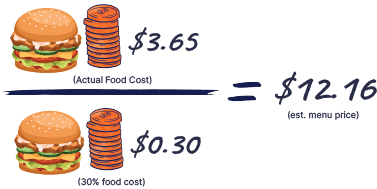Wondering what to charge for each item on your restaurant’s menu? It’s a tough nut to crack. You don’t want to be super expensive and turn people away. But on the other hand, your goal is to make money and be profitable.
The best way to figure out how to price your menu is to start with a simple math formula, add in some tips from Psych 101 and finish with classic design elements.
First things first, do you have your menu nailed down? Before you can think about how to price items on your menu, you need to be confident in your offers, including their names and descriptions.
Tips for creating a restaurant menu
If you haven’t ironed out all the details about what you’re including on your menu, take a step back and work on that first. Our best advice is to keep it simple and to be descriptive about what you’re cookin’ up.
Keep it simple
Having a small menu can make all the difference between success and struggle, especially when you’re first getting started.
“Simplifying your menu ensures that you’re going to get that handful of items right, that they’ll be consistent, and that they’ll be delicious and attractive to your customers.” – Ben Simmons, Table Needs CEO and restaurant owner
A simplified menu also makes it easier to keep track of inventories and supplies and easier to track what’s selling and what’s not. Tracking profit margins on 15 items is a heck of a lot easier than tracking 36 items.
Be descriptive
Time to get creative! Writing enticing descriptions is key to selling more items. Simple as that. Mouth-watering descriptions improve customer attitudes toward the food, attitudes toward the restaurant and a customer’s intentions to come back.
Not sold? How about this stat from the Association of Consumer Research:
Descriptive menu labels increased sales by 27%

Whether it’s in the name or the ingredients, think about how to elevate your menu descriptions from so-so to SO good.
Pricing your menu items
Get out your calculators… It’s time for MATH. Don’t fear, this is easier than Mr. Johnson’s Algebra 101 (and without all the judgment).
With your menu items and descriptions sorted, it’s time to decide how much you’re going to charge. Let’s start with a simple formula to calculate what to charge for every item on your menu:

For example: Your chicken sandwich costs you $3.65 to make (chicken, roll, aioli, pickle, lettuce) and the amount that your business spends on food costs is about 30% of your total expenses (this number is typically between 28-35%). You’re going to charge around $12.16 for this sandwich.
How much to charge for a Chicken Sandwich:

But wait, don’t just slap that price on your menu…there are a few other factors to consider that include a little psychology and your competition.
Menu pricing tips
Determining the minimum amount you should charge is only part of the process. The next step is to use a little Psych 101 to decide exactly what that dollar amount should be for each item on your restaurant menu.
Ditch the $$ sign
Your guests know that they’re going to be shelling out money, don’t rub it in their face. A study out of Cornell University found that guests who looked at menus with just numbers (5.25) spent significantly more than those who received a menu with $$ signs ($5.25).
End prices with .95
Another psychology trick is to end your prices with .95 instead of rounding up to the even dollar amount. Seems silly but at first glance, our brains think that there’s a WHOLE dollar between $5.95 and $6, even if it’s just 5 cents.
Add a flashy decoy
Quack! But seriously, if you want to sell more of your mid-priced food, setting one high-priced item makes the rest of your menu prices seem more reasonable to the customer. Suddenly those $12 sandwiches don’t seem too bad next to that $24 special.
Avoid price sinking
On the other hand, avoid pricing menu items too low – even if they’re super cheap to make. Keep pricing within each category relatively even. A $5 sandwich in the midst of $12 sandwiches will draw the wrong kind of attention.
Competitor pricing
Every restaurant has competition and it’s up to you to decide if your pricing will be the same, higher or lower than competitors. Before you slap on a price, think about what your pricing looks like from the customer’s point of view:
- Priced the same: What’s the real differentiating factor? Quality? Vibe? Unique options?
- Priced higher: Customer expectations are higher to jive with the extra cost
- Priced lower: Customers think you’re a bargain and their expectations are lowered
Menu layout tips
The way your menu is designed can also influence what sells and what doesn’t. If you want to sell more of a particular item – for example, something that is super profitable – then you need to make it stand out from the rest.
Here are a few ways to draw attention to a particular item on your menu:
- Place the item at the top-center of your menu. This is where customers’ eyes first land on your menu and it will influence the rest of their decisions.
- Within each category, highlight an item by either making the item name bold or placing a box around the item name and description.
- Space things out. A cluttered menu makes it really hard for your customers’ to focus and make decisions. Leaving extra space between items and categories helps.
Ready to create your restaurant menu?
As with all advice, these are guidelines. Give them a try and feel free to skip what doesn’t feel right. Do it your way!
If you want some extra help from restaurant experts, Table Needs is here. We create custom menus for every single one of our restaurant customers and work with them to figure out items, pricing and design, plus do regular check-ins to make sure it’s all working.
Follow us for tips, news, and tutorials to run a successful small restaurant.






